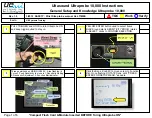
AMI Analyzer Manual
Installation Procedure
11
Calibrating the analyzer
The oxygen sensor gradually gets used up over its life, and as it does so its sensitivity
slowly drops until it is at the end of its life, when the sensitivity drops much faster.
Therefore you have to calibrate the sensor every so often to make sure that your readings
are correct.
There are two ways of doing this. You can use a span gas, a mixed gas containing a
certain level of oxygen in a background gas that ideally matches your sample, or you can
use air. The advantage of using air is that its value really is 20.9% and it doesn’t change;
the disadvantage is that it means that the sensor is exposed to air and so it will take a
while for the reading to come down again afterwards. Typically, at room temperature,
and AMI analyzer will take about fifteen minutes or less to come down to below 10ppm
after a one minute exposure to air.
The advantage of using a span gas is that you can calibrate it to a value close to the
range of interest – often people use 80ppm oxygen in nitrogen as the span gas. You may
have political reasons for having to do this. The sensor recovers from this level of oxygen
immediately so there is no down time before the analyzer is working properly again. The
disadvantage is that span gases sometimes are incorrectly made, and they can be
contaminated by improper handling. Also you will have to provide an external
sample/span selection valve.
Calibrating with a span gas
Fist put a suitable regulator on the span gas tank, and “bleed” it as described below.
This step is essential, since otherwise the air in the regulator will contaminate the gas in
the tank. Connect the regulator to the analyzer with a stainless steel line, and leak
check the connection with “Snoop™” or similar leak detection fluid. Purge the line for
several minutes with a small flow of gas prior to doing this, and leave the gas flowing
while you make the connection to the analyzer. This prevents a slug of air from giving
you excessively high readings when you start spanning the analyzer.
Make sure the analyzer is seeing a low oxygen level gas – you want the analyzer to go UP
to the span gas, not down to it, particularly not from air. Otherwise it will take a very
long time to get a good calibration.
When all is assembled, flow the span gas into the analyzer, and you should see the
reading move to the span gas value. Assuming it stabilizes somewhere reasonably close,
press the UP or DOWN button until the reading on the LCD shows what the span gas
bottle says the value should be.
Calibrating with air
You can either connect a compressed air line – from the plant air, not a bottle of
compressed air – to the sample inlet via a selection valve or you can shut off the flow and
open the cell cap on the front of the analyzer. If you use compressed air, go through the
same procedure as above, only adjust the oxygen reading to 20.9%.
If you do not have compressed air, unscrew the cell cap on the front of the analyzer.
Blow some air under the sensor by waving a book or some such at it. Adjust the reading
as before to 20.9% and then screw the cell cap back on the analyzer. Bring up the flow of
the sample gas.
In either case, make sure you don’t take more than a minute to do this. The reading may
not stabilize exactly at 20.9%, but don’t worry about that – any slight error will be
inconsequential at the operating levels.
Let the analyzer come down to a low reading on the sample gas.











































